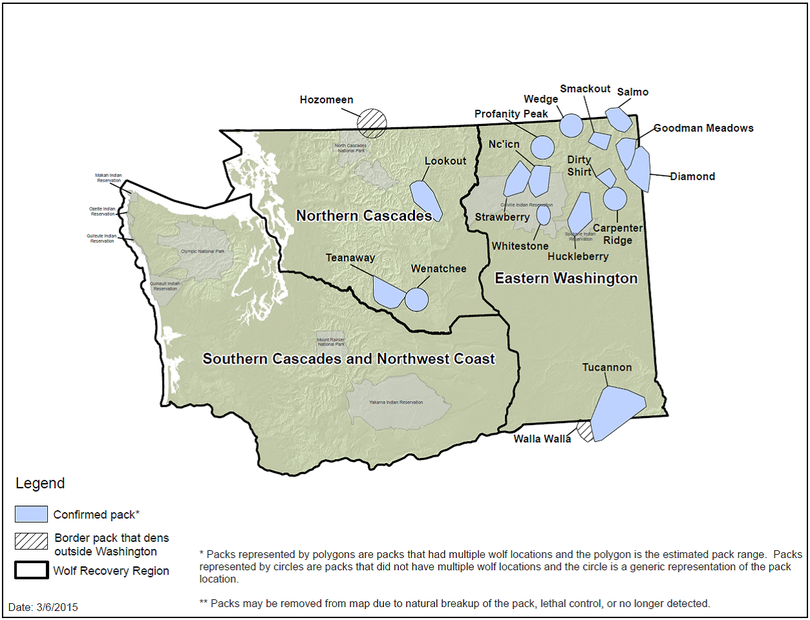Report: Washington’s wolves increased 30 percent in 2014

ENDANGERED SPECIES -- The wolf population in Washington grew by more than 30 percent and formed four new packs last year, according to an annual survey conducted by the state Department of Fish and Wildlife.
Field biologists documented at least 68 gray wolves in the state through Dec. 31, up from a minimum of 52 wolves counted in 2013, the agency said in a preliminary report released Friday.
The number of confirmed wolf packs increased to 16 with at least five successful breeding pairs, the report says. At the end of 2013, the agency had confirmed 13 packs and five breeding pairs.
“While we can’t count every wolf in the state, the formation of four new packs is clear evidence that wolves are recovering in Washington,” said Donny Martorello, department carnivore specialist. “Since 2011, the number of confirmed wolf packs has more than tripled in our state.”
The scarcity of winter snow made tracking wolves more difficult for this survey, he said, adding the survey likely underestimates the number of wolves, packs and breeding pairs.
Gray wolves, extirpated from western states in the early 1900s, have been declared recovered and delisted from federal endangered species protections in Montana and Idaho and are being managed by the states.
Wolves are protected under Washington law throughout the state and under federal law in the western two-thirds of the state.
The annual survey, required by the U.S. Fish and Wildlife Service, are conducted using aerial surveys, remote cameras, wolf tracks and signals from seven wolves in Washington fitted with radio-collars.
The four new packs – Goodman Meadows, Profanity Peak, Tucannon, and Whitestone – were discovered east of the Cascades, where all of the state’s other wolf packs roam. The state’s wolf management plan defines a pack as two or more wolves traveling together in winter.
Ten Washington wolf deaths were documented in 2014. Three were killed by poachers, three died of natural causes, two died of unknown causes and one was killed in a vehicle collision.
A breeding female was shot last summer as state wildlife officials tried to stop the Huckleberry Pack from preying on a rancher’s sheep in Stevens County.
A record number of wolf-related livestock deaths also was confirmed in Washington’s annual report. The Huckleberry Pack accounted for 33 of the 35 sheep killed or injured by wolves. The report says actual losses were surely higher.
Four cows and a dog were attacked by wolves from other packs last year, the report says.
Wildlife officials say they will continue to emphasize the importance of prevention practices to minimizing wolf attacks on livestock.
Martorello said the number of packs would have been even higher if not for the loss of the Ruby Creek pack last spring. One of its two members was struck and killed by a vehicle. The other was accepted for care by Wolf Haven International in Tenino after it was found living among domestic dogs in a small town in Pend Oreille County.
Stephanie Simek, a department wildlife conflict manager, said the agency is working on:
- Expanding partnerships with ranchers to avoid conflicts with wolves. The department has stationed wildlife conflict specialists in communities where wolves are recovering to work with individual producers.
- Expanding its “range rider” program, where ranchers can turn for help if they need assistance guarding their livestock. Range riders have been used by several producers, and the state program will provide an increased human presence in grazing areas.
- Informing livestock owners of the availability of a new carcass pit in Ferry County where they can dispose of dead livestock and other attractants.
- Continuing to offer cost-sharing agreements for ranchers who seek help in funding preventive measures to protect their animals.
In a preliminary media release, Martorello notes several times that the official minimum estimates very likely is short of actual wolf numbers and packs.
“Given the continued growth of the state’s wolf population, there’s a good chance that we have breeding pairs east of the Cascade Range we haven’t found yet,” he said.
No wolf packs or breeding pairs have yet been documented on the South Cascades/Northwest Coast recovery region.
Under the state’s Wolf Conservation and Management Plan, wolves can be removed from the state’s endangered species list once 15 successful breeding pairs are documented for three consecutive years among the three designated wolf-recovery regions.
WDFW’s wolf survey for 2014 will be available on the department’s website at by April 3.
